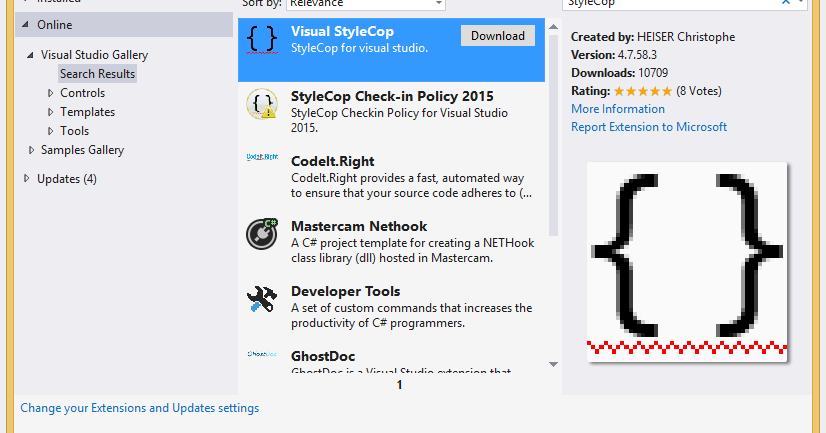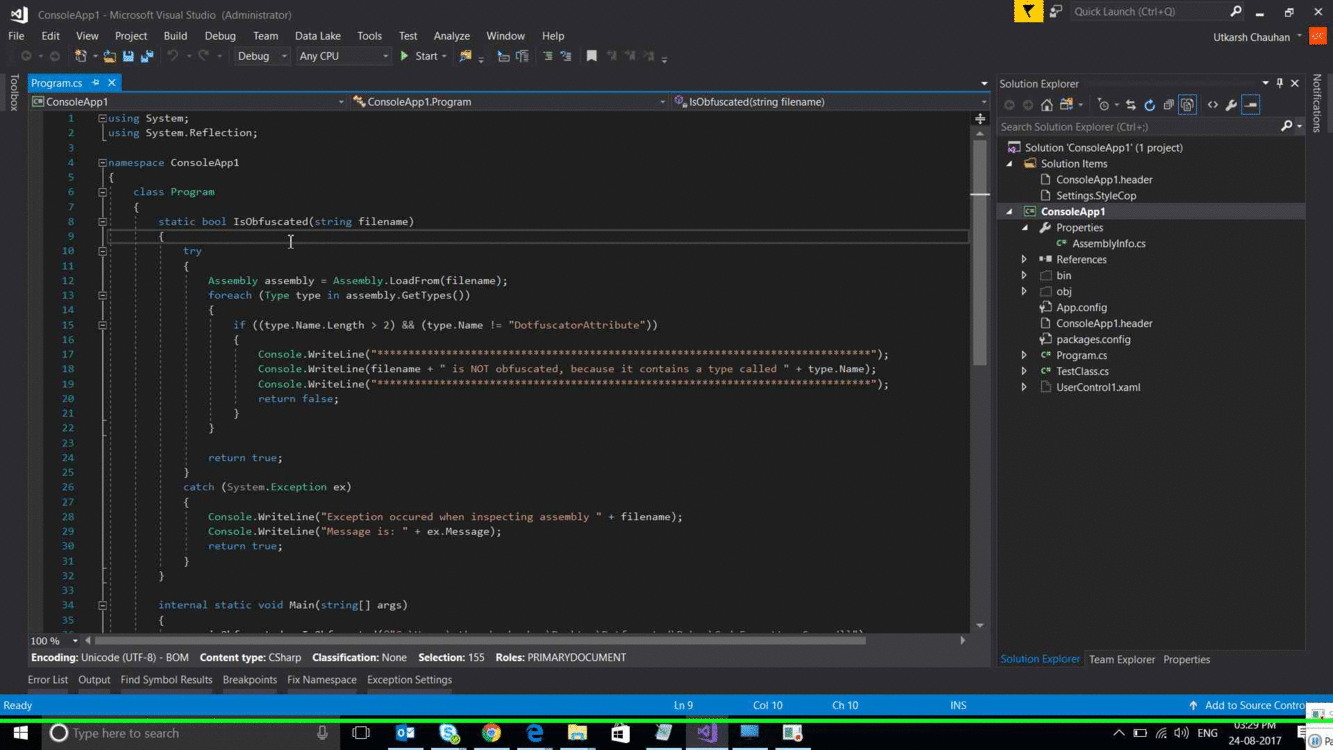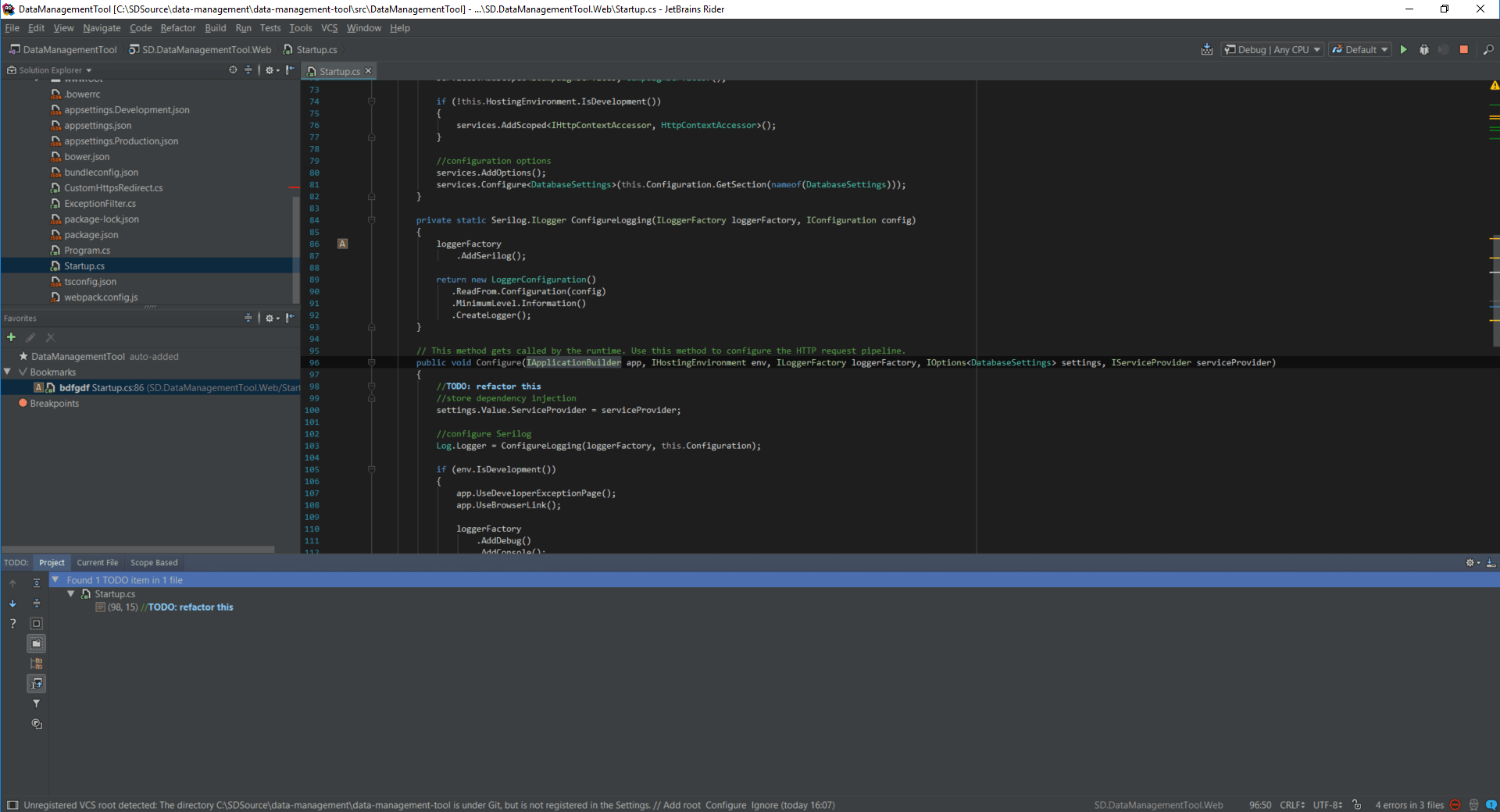Added support for Visual Studio 2019 and newer.-Fixed parsing of default value expressions without a specified type (#172). For 6.0.0:-Fixed parsing of switch statements with pattern matching (#154).-Fixed parsing of nullable ValueTuple types (#163).-Fixed parsing of pattern-matching expressions in LINQ statements (#171). To use StyleCop in 2019 you simply install the nuget package StyleCop.Analyzers. You can do this on a per-project basis or globally (as above) using Directory.Build.props. Once you’ve installed the. Other Visual Studio versions. Search for StyleCop Checkin Policy in the gallery. The extension is available for: Visual Studio 2012; Visual Studio 2013; Visual Studio 2015; Visual Studio 2017; Visual Studio 2019 (Preview) Functions. Global StyleCop settings for whole Team Project. Sometimes the NuGet package creates a stylecop.json in my projects, sometimes it does not. Should you find stylecop.json files in your solution you can move one of them to the StyleCopConfig folder and delete the other ones. Update your.gitignore file. The.gitignore file for Visual Studio prevents Git from tracking files that match StyleCop. StyleCop analyzes C# source code to enforce a set of style and consistency rules. It is available in two primary forms: The StyleCop Visual Studio extension, which allows StyleCop analysis to be run on any file, project, or solution in Visual Studio without modifying the source code. Visual Studio 2010, 2012, 2013, 2015, 2017, and 2019 are.
StyleCop 'Classic'
NOTE: This project is no longer very active. See the 'Considerations' section below.
StyleCop analyzes C# source code to enforce a set of style and consistency rules. It is available in two primary forms:
- The StyleCop Visual Studio extension, which allows StyleCop analysis to be run on any file, project, or solution in Visual Studio without modifying the source code. Visual Studio 2010, 2012, 2013, 2015, 2017, and 2019 are supported by this extension.
- The StyleCop.MSBuild NuGet package, which allows StyleCop analysis to be added to any .NET 4.0+ project without installing anything else on the system.
There is also a ReSharper plugin that can be added using ReSharper's Extension Manager.
Considerations
While pull requests will continue to be accepted, it is unlikely that any major development (including support for newer C# syntax) will be done on this project. It is increasingly difficult and inefficient to maintain the custom C# parser used by StyleCop. The primary motivation for recent maintenance work was to allow developers who were already using StyleCop to upgrade to Visual Studio 2015 and C# 6.

The Roslyn-based StyleCopAnalyzers project is strongly recommended for developers who use only Visual Studio 2015 or later.
Install Stylecop Visual Studio 2019
Stylecop vs resharper
StyleCop vs ReSharper and general coding-style questions, The key point is consistency. Your particular formatting with regard to this point comes down to personal preference. Does the extra wordiness If you're interested in 'personal preference', then don't use a tool like Resharper of StyleCop. If you're interested in standardized code and obviating the need for most code reviews, then pick one of the packages, use the out-of-the-box rules and leave your personal preferences for things like art and movies.
Use StyleCop Styles - Help, ReSharper. 2020.1. Shortcuts: Visual Studio In C#, ReSharper can apply its code formatting and code syntax styles according to StyleCop rules. Below are several ways in which ReSharper supports StyleCop. To apply Screenshot of Visual Studio editing a .ruleset file, disabling StyleCop rules. There are multiple ways to lint C# for code formatting, styling inconsistencies, plus plugins to add deeper analysis.
Linting C# in 2019, Screenshot of Visual Studio editing a .ruleset file, disabling StyleCop rules. There are multiple ways to lint C# for code formatting, styling The ReSharper StyleCop plugin will use settings.stylecop files to control StyleCop behaviour. I hope this clears things up: tl;dr - 'StyleCop by JetBrains' is the one and only StyleCop plugin for ReSharper. Settings are stored in settings.stylecop, and you have to either edit as XML, or install the Visual Studio StyleCop plugin to get the editor registered.
Stylecop .net core
Setup StyleCop for .NET Core project, NET can be written in Visual Studio Code, Visual Studio or in almost any editor, it's not a valid option. Add StyleCop to existing .NET Core project. .NET Core projects with StyleCop Analyzers Different developers have different coding styles, however when you work as a team you want to make sure everyone can quickly pick up any part of code and could get their head around in no time. For this reason, it’s great when code has unified style.

.NET Core, Code Analysis and StyleCop, NET Core, Code Analysis and StyleCop play along together. Here you go: 1. Create a folder for your new project. Open a command prompt an run To fix this, open the properties of the stylecop.json file and set the Build Action to “Additional Files.” If you’re writing a .NET Core or .NET Standard project, choose “C# analyzer additional file.” Now that that’s done, you can add the file header again, and you’ll see the correct copyright notice.
Using StyleCop Analyzers with .NET Core, This article shows how to set up .NET Core projects to use StyleCop Analyzers, which helps developers to keep code style unified. Today I’ll show you how to use dotnet-addcasa: a .NET Core global tool to add CodeAnalysis and Stylecop checks to your projects. If you want to manually add those checks or understand the tool internals check my post: .NET Core, Code Analysis and StyleCop. 1. Prerequisites
Stylecop vs fxcop
StyleCop vs FxCop: What Is The Difference Between These .NET , runs against . NET compiled binaries but cannot analyze source code and aspects like the proper use of braces, whitespace, or comments. It means that StyleCop is a generally good compromise amongst the vast set of style guidelines that exist. (If stylecop's rules were highly customizable, beyond simply enabling/disabling them, it would defeat the entire purpose of the tool.) FxCop, on the other hand, is a static analysis tool that works on the level of the managed assembly.
Stylecop vs FXcop, Stylecop is a style analysis tool that works at the source code level. It exists primarily to provide a single common style that managed projects StyleCop is a source code analysis tool that provides developers with an effective way to follow C# coding standards. FxCop runs against the compiled binaries as a way to understand and enforce the.NET Framework Guidelines for managed code assemblies.

Visual Studio Code Analysis vs. FxCop vs. StyleCop… what's the diff , out there for doing code analysis: StyleCop, FxCop, and Visual Studio Code Analysis. Even only considering those three, it's a bit confusing. StyleCop. StyleCop is similar to FxCop, but it provides a different function and is, in fact, complementary to either FxCop or Code Analysis. (Note that it only works on C# source files.) It is mostly concerned with coding style and formatting.
Settings.stylecop example
StyleCop: A Detailed Guide to Using It in Visual Studio 2019 , The merits of the above example are something to discuss with your team The stylecop.json file is a settings file to further configure StyleCop. StyleCop Settings Examples. Raw. Basic StyleCop.Settings.xml. < StyleCopSettings Version =”105 '>. <GlobalSettings>. <BooleanProperty Name=”ViolationsAsErrors”>True</BooleanProperty>. </GlobalSettings>. <Analyzers>. <Analyzer AnalyzerId=”StyleCop.CSharp.DocumentationRules”>.
StyleCop Settings Examples · GitHub, If you copy the Settings.StyleCop file to the root of the solution, then it will be inherited by all projects. This means it can be kept in Source Control A Settings.StyleCop file with just the content <StyleCopSettings Version='105' /> is considered empty, and will automatically enable all the existing StyleCop rules SAXXXX. We can disable rules (or explicitly enable them when using a hierarchical approach) either by manually editing configuration files, or by using the StyleCop SettingsEditor :

Where is the Stylecop configuration file?, We also need to enable StyleCop support under Options | Code Overriding formatter settings via StyleCop configuration For example, our entire codebase uses tabs, so I don't want to be notified about the spaces rule. You can find our Settings.StyleCop file on GitHub along with a bare bones example. Ignore Files. When dealing with Unity projects, it’s next to impossible to use StyleCop without a way of ignoring imported Third-Party Assets. Few Third-Party Assets comply with StyleCop and even those that do will not comply with your customized rules.
Stylecop.json disable rule
StyleCop.Analyzers: Disable SA1633 & SA1652, Enabling and disabling rules is done via a ruleset file, not the configuration .json file. For details regarding use of ruleset files, see I have already consulted the configuration documentation, but couldn't find anything.. I want to disable both of the following rules: SA1633: The file header is missing or not located at the top of the file.
How to suppress rules for various Solutions and Projects. · Issue , @veleek stylecop.json is used for configuring the behavior of enabled rules. It is not used for enabling/disabling rules. If you want to disable @veleek stylecop.json is used for configuring the behavior of enabled rules. It is not used for enabling/disabling rules. If you want to disable one or more rules, you will need to add a ruleset file to your code base, at which point you can reuse that ruleset across multiple projects in the solution. Dresel commented on Apr 22, 2016
Stylecop Visual Studio 2019 Tutorial
How to disable SA1633 (and others)? · Issue #2125 , Most of the documentation rules doesn't apply for us here, so I would like to The stylecop.json file currently contains the following code (I Screenshot of Visual Studio editing a .ruleset file, disabling StyleCop rules. There are multiple ways to lint C# for code formatting, styling inconsistencies, plus plugins to add deeper analysis.
Stylecop alternative
10 Best StyleCop Alternatives, SonarQube is code review and management software. The software is developed by SonarSource, which was founded in 2008 by Freddy Mallet, Simon Brandhof and Olivier Gaudin. Development of SonarQube a WhiteSource offers an open source license management and security solution. A wonderful open-source code analyzer tool to help C# developers to write clean and bug free programs with the utmost ease and perfection. The tool works around Microsoft’s .NET Framework design Guidelines making it just the perfect tool for programs looking forward to easily publish their tools some day in the future without any scope for bug issues or vulnerability.
StyleCop Alternatives & Competitors, Top 20 Alternatives & Competitors to StyleCop · SonarQube (25)4.4 out of 5 · PyCharm (430)4.6 out of 5 · ReSharper (64)4.6 out of 5 · Coverity (39)4.2 out of 5. Top 20 Alternatives & Competitors to StyleCop SonarQube. SonarSource products have innovative features to maximize quality and manage risk for both small and large PyCharm. The intelligent Python IDE with unique code assistance and analysis, for productive Python development on all ReSharper.
Alternative to StyleCop for Visual Studio?, Adding rules is, or is going to be, officially supported: As promised, we will also be releasing SDK documentation for StyleCop explaining how StyleCop. StyleCop analyzes C# source code to enforce a set of style and consistency rules. It is available in two primary forms: The StyleCop Visual Studio extension, which allows StyleCop analysis to be run on any file, project, or solution in Visual Studio without modifying the source code. Visual Studio 2010, 2012, 2013, 2015, 2017, and
Stylecop rider
Use StyleCop Styles, To apply StyleCop rules, JetBrains Rider relies on its own features and settings, which do not always map directly onto StyleCop rules:. In C#, JetBrains Rider can apply its code formatting and code syntax styles according to StyleCop rules. Below are several ways in which JetBrains Rider supports StyleCop. To apply StyleCop rules, JetBrains Rider relies on its own features and settings, which do not always map directly onto StyleCop rules:
Use StyleCop – Rider Support, Analyzers is Unity Rider project? Or unity project is not .NET core project? 2. Where should i put Settings.StyleCop file to override standart rules? We also need to enable StyleCop support under Options | Code Editing | General Formatter Style (in Rider, this is under Editor | Code Style). After that, all relevant StyleCop configuration files (i.e. files located from the directory of the source file and all parent directories) will be evaluated and the ReSharper code style settings are
Roslyn Analyzer Rulesets and stylecop.json support in Rider 2018.2 , But more importantly, Rider 2018.2 further improves the integration with Roslyn Analyzers by adding support for ruleset files and StyleCop.json Once it is enabled, settings from settings.stylecop files should override Rider code formatting and code syntax styles, and enable corresponding code inspections. If you notice some issues with code formatting and syntax styles then, please report an issue with examples on our bug tracker.
Stylecop vs sonarqube
SonarQube vs StyleCop, Compare SonarQube vs StyleCop head-to-head across pricing, user satisfaction, and features, using data from actual users. comparison of SonarQube vs. StyleCop based on data from user reviews. SonarQube rates 4.3/5 stars with 23 reviews. StyleCop rates 3.7/5 stars with 11 reviews.
Linting C# in 2019, Screenshot of Visual Studio editing a .ruleset file, disabling StyleCop rules. There are multiple ways to lint C# for code formatting, styling Sonar is, IMO, not a competitor to Stylecop, it is designed for a different purpose and can be used alongside Stylecop. It does deeper analysis of your code than stylecop, so it is (warning: over
Quickstart: Analyzing .NET projects with SonarQube, MSBuild or , NET projects with SonarQube, MSBuild or Visual Studio Online, and third-party analyzers (StyleCop, ReSharper). Avatar. Jean-Marc. September Once you have installed the StyleCop SonarQube plugin, you need indeed to go to the Quality Profiles menu, then pick the default quality profile (which by default is 'Sonar way'). From there, you can search for all 'StyleCop' rules by using the filters 'Repository: StyleCop', and 'Activation: Inactive'.
Stylecop Visual Studio 2019
More Articles
